We often think of the body as a system that runs on caloric energy obtained through the carbohydrates, proteins, and fats that make up our diets. This is true to a degree, as each of these macronutrients uniquely impact our health and energy expenditure. That being said, the process of producing energy and using it in the body isn't quite as simple as "Eat nutrients; use nutrients." The body breaks down and converts nutrients through various mechanisms in an effort to facilitate all the functions the human body is responsible for.

We commonly hear about the importance of energy molecules like ATP, but how do we create them? Meet the building blocks of DNA and RNA, nucleotides.
One such breakdown that proves vital to overall health and wellness consists of nucleotides — organic molecules that are essential to almost everything in the body, from DNA and RNA construction to metabolic functioning.
A family of compounds that consists of all-important molecules like adenosine triphosphate (ATP), nucleotides serve a central role in virtually every area of the body, and, as such, are crucial to overall health. Generally manufactured through different methods in the body, nucleotides can also be ingested -- through both foods and supplementation -- to ensure we're working with a large enough supply to maintain top-notch functioning.
NucleoPrime from NNB Nutrition is a high-quality, 100% pure formulation of exogenous nucleotides. It delivers four different nucleotides that form the basis for much of what this group of organic compounds accomplishes in our systems.
Capable of improving
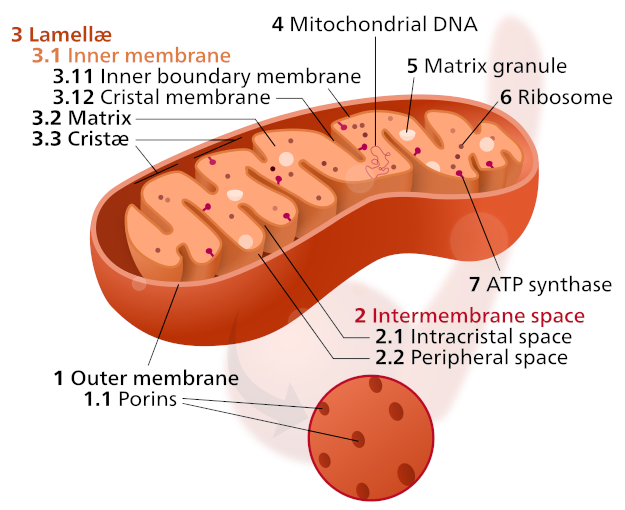
A single mitochondrion, the "powerhouses" of our cells that generate ATP, the "energy token" in the body. How can we help them create more ATP though? By providing more of their nucleotide building blocks! Image and labeling courtesy Wikimedia.
- energy production,
- exercise performance,
- recovery,
- immune functioning,
- gastrointestinal health,
- and even cognitive performance,
Thanks to the wide-spanning reach of nucleotides in the body, NucleoPrime is capable of providing various benefits, namely through its ability to help the body and its mitochondria generate more ATP.
In this post, we tell you all about nucleotides -- what they are, how they're made, and what they do -- while also covering yet another innovative ingredient from NNB Nutrition, NucleoPrime. Before we get to that, make sure you're subscribed to PricePlow for news and deals alerts. Also, be sure to check us out on social media for supplement content that includes supplement reviews, ingredient breakdowns, and industry interviews:
Subscribe to PricePlow's Newsletter and Alerts on These Topics
What are nucleotides?
According to the National Human Genome Research Institute, nucleotides are generally described as the building blocks of nucleic acids, like deoxyribonucleic acid (DNA) and ribonucleic acid (RNA), which are molecules that store and transcript genetic information.[1] In other words, these molecules essentially dictate genetic coding, not only in humans but in nature at large. Composed of phosphoric acid, a nitrogen base, and pentose sugar, there are five nucleobases — adenine, guanine, cytosine, thymine, and uracil — that form nucleotides, which when stranded together, form nucleic acids.[2]

Nucleotide are the basic building block of nucleic acids, and RNA and DNA are polymers made of long chains of nucleotides. The bases used in DNA are adenine (A), cytosine (C), guanine (G), and thymine (T). In RNA, the base uracil (U) takes the place of thymine. Image courtesy National Human Genome Research Institute.
Mechanism and biochemistry discussed below
Normally, at this point in the article, we discuss the mechanism and background behind the ingredient before heading into its application and benefits. However, in this case, the underlying science is so heavy on biochemistry that it will lose most readers, so we've moved it to the end of the post for those who need that level of detail.
The simple story is that nucleotides combine with sugar molecules such as ribose or deoxyribose to form RNA or DNA, respectively. Outside of supplementation, they are synthesized a few different ways, there are different pathways involved in their creation. They go on to support key energy "tokens" and "messengers" such as ATP, cAMP, and NAD, which are critical to health, wellness, and longevity.
How important are nucleotides and what do they build?
While the discussion about nucleotide synthesis is heavy on chemistry, the resultant products of those processes are important to healthy consumers. In fact, there are quite a few nucleotides that you've likely heard about before, be it through high school biology or other research. Though they can be used to form long-chain nucleic acids, individual nucleotides (and cyclic nucleotides, which have their phosphate group linked to its sugar twice) are rather influential:
- Adenosine triphosphate (ATP) is the source of energy used at the cellular level that drives virtually every bodily process.[3] This nucleotide is generated by the mitochondria through cellular respiration. Its hydrolyzed variants (ADP and AMP) are also vital to its creation.[3]
- Guanosine triphosphate (GTP) is, like ATP, influential in energy production and protein synthesis.[4]
- Uridine triphosphate (UTP) facilitates the synthesis of glycogen from glucose, proving to be a key provider of usable energy to the cells.[5]
- A messenger activated by G protein-coupled receptors (GPCRs), cyclic adenosine monophosphate (cAMP) signaling facilitates various cellular processes, including myogenesis and metabolic adaptation.[6]
- Nicotinamide adenine dinucleotide (NAD) and its relative molecules (i.e. NADP) facilitate numerous cellular reactions, including those that take place during cellular respiration.[7]
The above molecules are all critically important, and as we'll cover later on in this article, supplemental nucleotides like AMP and GMP are easily turned into ATP and GTP,[8] which makes them incredibly useful.
The above list is by no means an expansive list of all the nucleotides at work in the body, nor does it cover everything they do. Comprehensive research studies have been conducted on the various roles that nucleotides serve. These brief points simply highlight their overall impact at a high level.
Below are four major ribonucleotides, which are the structural units of RNAs, all of which will be investigated for their collective value as supplements:
| Nucleotide | Symbols | Nucleoside |
|---|---|---|
| Adenylate (adenosine 5'-monophosphate) | A, AMP | Adenosine |
| Guanylate (guanosine 5'-monophosphate) | G, GMP | Guanosine |
| Uridylate (uridine 5'-monophosphate) | U, UMP | Uridine |
| Cytidylate (cytidine 5'-monophosphate) | C, CMP | Cytidine |
Nonetheless, it's obvious that the human body depends on these molecules in a multitude of ways, at various biological stages. They have a heightened level of importance in energy production and protein synthesis, as well as in cells with a high turnover rate, such as those in the immune system and digestive tract.[9,10] However, this relative importance does not guarantee efficient functioning, nor their presence.
A solution to potential nucleotide deficiencies?
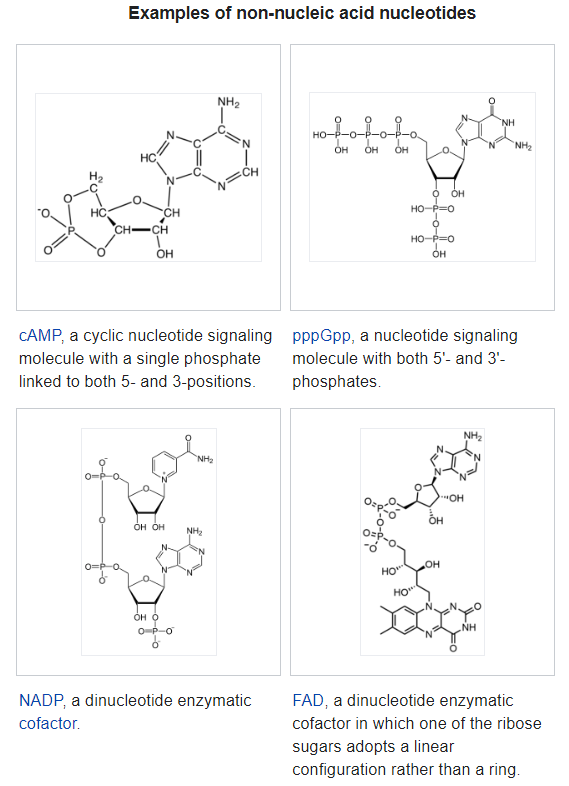
Wikipedia has a nice list of non-nucleic nucleotides. cAMP is one that we love to generate, and often discuss supplements that support higher cAMP levels.
Because nucleotides are typically formed endogenously, the body depends on the presence of specific nutrients and enzymes to build them. In addition to requiring sufficient amounts of relevant compounds to actually synthesize these molecules, efficient operation of the mechanisms that either help build or utilize them is also necessary. Issues at the cellular level, such as mitochondrial dysfunction, could be problematic in terms of nucleotide balance, as well.
With a central role in cellular respiration, potential deficiencies could lead to issues with energy production and cognitive ability. Additionally, diseases could impair the body's ability to effectively produce and use nucleotides, resulting in even more complications. As such, there's at least one way to help alleviate some of these issues: exogenous nucleotides.
Science behind dietary nucleotides
The idea of supplementing with dietary nucleotides isn't too novel. Just as individuals with protein deficiencies supplement with protein to make up for gaps, the same can be said for these critical building blocks. However, a theory is one thing, but evidence to support it is another entirely. Luckily, there does seem to be research supporting the use of exogenous nucleotides to circumvent issues related to nucleotide deficiency.
-
Improved athletic performance and recovery
With nucleotides holding a vital role in energy production, analyzing the potential of exogenous nucleotides in terms of athletics — where cellular energy is at a premium — makes for an excellent place to start.
Muscles use nucleotides to exert energy
Laying the groundwork for the benefits of more nucleotides in the body, we see a direct near-1:1 relationship between TAN depletion and IMP accumulation during 30 second sprints[11]
Research has demonstrated the importance of nucleotide availability in the face of strenuous, energy-demanding events, such as exercise. In a 2000 edition of Journal of Applied Physiology, a team of scientists gathered seven men and analyzed the relationship between available nucleotides before and after sprint cycling intervals. Specifically, the researchers were interested in how volunteers' muscle total adenine nucleotide pools (TAN) — the total amounts of ATP, ADP, and AMP — and IMP levels fluctuate. Because adenine nucleotides are typically formed through the reamination of IMP, the researchers hypothesized that increases in TAN should correlate with decreases in IMP, and vice versa.[11]
Sure enough, their results confirmed this relationship while also highlighting its relevance in terms of energy exertion. The study authors found that during 30 seconds of sprint cycling, muscle TAN content decreased while muscle IMP increased, almost at a 1:1 ratio[11]. As the subjects recovered from their sprint, the inverse was observed — muscle TAN increased with rest, while muscle IMP decreased.[11]
These findings weren't exactly groundbreaking. They simply reiterate what most of the science revolving around nucleotides supports —the body needs them to function, and they're particularly integral in creating and expending energy. As such, it's reasonable to suggest that introducing an exogenous supply of nucleotides to the body could help keep nucleotide pools well-stocked, potentially maintaining performance during exercise.
Exogenous nucleotides support exercise performance...
In a recent study supported by NNB Nutrition, researchers tested the effects of exogenous nucleotides in multiple markers of athletic performance, measuring metrics such as peak anaerobic power and power fatigue. In this study, nine subjects initially performed four high-intensity intervals on an exercise bicycle, each consisting of a 30 second sprint followed by two minutes of rest, for four intervals. After this initial baseline test, the volunteers were administered 500 milligrams of exogenous nucleotides in the form of NucleoPrime, NNB's patented ingredient. After seven days, they repeated the cycling test.
Though no significant differences were seen between the two sessions, improvements were seen when comparing within-session performance. Prior to treatment, subjects showed significant decreases in absolute anaerobic peak power (PP) and relative anaerobic peak power (RP) with each successive interval. For example, the subjects' fourth sprint was significantly lower than their second.[12] Following nucleotide treatment, however, there was no significant drop-off in peak power (for both PP and RP) between sprints.[12] Subjects seemed to be stronger, too. According to the mean absolute difference of PP and RP, the third and fourth sprints were more powerful in the second trial when compared to the first. Additionally, there were no significant differences in fatigue post-supplementation, despite seeing statistically significant differences between intervals in the baseline test.[12]
...and possibly enhance recovery
This trend persisted into perceptual measures, as well. Subjects reported perceived recovery status scale (PRS) scores 48 hours after sprinting that were significantly lower than those reported prior to the sprints in the baseline test. However, this wasn't true following treatment. Subjects felt better recovered 48 hours after sprinting during the second trial.
Nucleotides reduced serum cortisol levels compared to baseline/placebo, which could have a tremendous number of effects on athletes.[12]
Additionally, blood samples collected provided further evidence of positive effects induced by nucleotide supplementation.[12] The researchers found cortisol levels were lower 48 hours post-exercise in the second trial. Because cortisol is a hormone linked to high levels of stress and poor recovery,[13] this indicates improved recovery in the NNB trial.
Similar results were seen in another study, published in a 2007 edition of the Journal of Sports Medicine and Physical Fitness. In this test, 30 trained males completed a two minute maximal exercise test before being randomly assigned to one of three groups: control, placebo, or nucleotide supplementation. After 60 days of treatment (taking either the placebo or the nucleotide supplement), the individuals returned and repeated the exercise test. Comparing metrics between the two assessments, the scientists found that those who took nucleotides displayed significantly lower cortisol levels than the other two groups.[14]
These findings support the notion that nucleotides can elevate athletic performance. In almost all forms of training and competition, it's imperative to maintain high performance despite the development of fatigue. This is true whether you're talking about the third set of some heavy back squats, an interval during a track workout, or even the fourth quarter of a sporting event. Additionally, the ability to recover effectively has a direct impact not only on rebuilding quickly after completing training but being able to bounce back sooner, too.
-
Higher endurance levels
Of course, the above benefits are intrinsically related to endurance — the ability to maintain a certain level of performance over time, by definition, is endurance. In a 2013 study published in Nutrients, researchers were interested in the effects of dietary nucleotides on prolonging time to exhaustion.[15] In a double-blind, placebo-controlled, randomized trial, 30 physically active men completed a treadmill test and then were assigned to one of two groups. One group was given a daily nucleotide supplement at 50 milligrams per dose, while the other was given a placebo. After 14 days of treatment, the men repeated their treadmill test. The scientists analyzed various metrics to assess the effectiveness of the nucleotides in relation to fatigue — time to exhaustion, peak heart rate, and peak running speed — as well as immune responses, such as fasting white blood cell count, natural killer (NK) cells, and serum immunoglobulin, which also relate to overall fatigue levels.
Comparing each group's performance at day 14 to their original baseline scores, the researchers found that the nucleotide group showed significantly higher times to exhaustion, serum immunoglobulin A (IgA), and NK cell activity than placebo.[15] These results led the team to conclude that nucleotide supplementation enhances endurance, not only through increasing available nucleotide pools, but also through modulation of the immune system.[15]
-
Immune health
The body uses nucleotides for a variety of things, including energy production, which is the relationship at the center of what we've discussed thus far. However, they also hold significant importance for immune function as well.
Immunomodulation via cortisol suppression and IgA expression
The immune system is the body's primary line of defense against foreign stressors. It helps protect bodily mechanisms from various dangers, including pathogens and other harmful bacteria, environmental stresses, and psychological stresses. In other words, when any process integral to our health is at risk, the immune system is called on to help straighten things out. To do so, it calls on lymphocytes, cytokines, hormones, and other immunomodulatory mechanisms. The tissues that help produce these defense mechanisms, such as those in the intestine, have a high nucleotide turnover rate, and therefore require ample nucleotide pools from which to draw.[16]
In fact, the performance-related benefits we've already touched on highlight the relationship between nucleotides and immune function — physiologic stress, as experienced during exercise, has an immunosuppressive effect.[17] This triggers a rather complex response that includes the release of NK cells, various hormones (cortisol, epinephrine), and both anti-inflammatory and pro-inflammatory cytokines.[17] In an acute fashion, this is an entirely natural response and isn't worrisome. However, things like chronic stress can be quite the burden on the immune system, leaving it in an overworked state that ultimately wreaks havoc not only on nucleotide levels, but on the entire body.
It's not quite hyperbole to state that the modulation of immune functioning and its efficiency is one of the most important components of health. Though there are various ways in which to do this, supplementing with exogenous nucleotides is one of the many avenues one can take toward immune support.
The previously mentioned 2013 Nutrients study observed significant raises in both serum IgA and NK cell activity after strenuous exercise in individuals who had supplemented with dietary nucleotides for 14 days. IgA, an antibody blood protein, and NK cells, regulatory lymphocytes, are both integral components of a healthy immune response.[18] By amplifying the levels of these two constituents, nucleotide supplementation was effectively providing an immunoregulatory action.
The exercise tests conducted in this study represent just one of many potential situations in which an environment could strain the immune system. A 2018 study from the Journal of Sports Science & Medicine found that instances of mental strain (such as refereeing sports matches) can significantly raise cortisol levels while decreasing IgA, depressing the immune system in ways similar to that of physical exercise.[19] As such, the cortisol-reducing and immunomodulatory effects of exogenous nucleotides apply in more than just circumstances in which physical stress is concerned.
Protects lymphocyte function
In previous articles, we uncovered some connections between medium chain triglycerides (MCT) and immunity as well. The similarity to nucleotides? They're both mitochondria-friendly!
Lymphocytes, also known as white blood cells, produce antibodies and cytokines that carry out the bidding of the immune system. Protecting their integrity is vital to immune health, and thus, is an area of scientific interest.
In an animal-based study published by researchers from the University of Ljubljana in 2005, male pigs were split into three groups based on diet. One group was fed standard starch, another was fed a high-fat diet, and the third was given a high-fat diet plus dietary nucleotides. After 21 days of feeding, the researchers found that the high-fat diet plus nucleotide group had significantly less lymphocyte DNA damage than the pigs who were just fed the high-fat diet alone.[20] Considering that a diet high in fatty acids can impair lymphocyte function,[21] the ability of nucleotides to step in and essentially attenuate the DNA damage typically caused by such a regimen is noteworthy.
-
Gastric health
The immunoregulatory responsibilities that nucleotides hold, and the ability of dietary nucleotides to amplify them, carry additional benefits within the area that maintains immune homeostasis — the gut.[22] While most commonly associated with its role in facilitating digestion, the gastrointestinal tract also houses the largest number of immune cells in the human body.[22] Thus, maintaining a healthy gut helps keep the immune system — and all the mechanisms it affects — running efficiently.[23]
Protective against gastric injury
In a 2006 edition of Gut, researchers from the Department of Gastroenterology of Imperial College in London, United Kingdom, assessed the gastroprotective effects of nucleotide supplementation. The study authors performed two experiments: in vitro and in vivo.
In the first study, the team added exogenous nucleotides to human colonic carcinoma (HT29) and rat intestinal epithelial (IEC6) cells with the hope of observing signs of wound repair. In treating the culture with nucleotide mixtures at various dosages, they saw a dose-dependent increase in cell migration, with maximal stimulation seen at 1mg/ml.[24] Because the rate of cellular migration increases in response to injury, this finding suggests that treatment could be effective in repairing damage at the cellular level. These results were most conclusive with a mixture of nucleotides: AMP, CMP, GMP, and IMP.[24] Furthermore, in testing each individual nucleotide in isolation, the scientists found that AMP encouraged cell proliferation in HT29 cells, whereas single administration of the other three yielded no significant results.[24]
Compared to saline, various doses of mixed nucleotides prevented large amounts of gastric damage[24]
In the second procedure, mice that were fed a standard chow were randomized into groups based on gastric gavage interventions. One group received saline, three received a nucleotide mixture (either 4, 8, or 16 milligrams per milliliter), while the final positive-control group was given epidermal growth factor (EGF). The researchers found that the mice administered treatment saw significant reductions in induced gastric damage compared to controls,[24] with the 4 and 16 milligram per milliliter groups showing better results than the 8 milligram per milliliter group.[24] Both procedures tested in this study offer support for nucleotides as protective agents against gastric injury.
Improve symptoms of gastric-related issues in humans
In a 2006 study published in Nutrition Journal, a team from University of East London in London, UK, assessed these gastroprotective effects in humans with irritable bowel syndrome (IBS). Individuals diagnosed with IBS tend to experience symptoms such as abdominal pain, diarrhea, and bloating, while the development of the issue can oftentimes be traced back to other conditions relating to poor health, diet, or stress.[25] Because nucleotides may be beneficial in these instances, the team hypothesized that treatment could help alleviate symptoms of IBS.[25]
37 subjects were split into two groups: one received a placebo for 56 days followed by treatment for 56 days, while the other followed the same procedure in reverse. Treatment consisted of 500 milligrams of nucleotides taken three times per day. The study authors found that symptom severity decreased during the treatment periods of both groups by roughly 4 to 6%,[25] with subjects reporting improvements in abdominal pain as the most conclusive effect.[25] This application provides evidence of dietary nucleotides as a means of improving symptoms of gut-related conditions.
-
Potential cognitive benefits
Preliminary research suggests that nucleotide supplementation may offer cognitive support. In a 1996 study published in Life Sciences, a team of researchers from Japan tested the effects of a mixture of nucleotides and nucleosides in mice with memory deficiencies.[26] This study used two experiments: the first tested the mixture exclusively in older mice), while the latter used younger mice with memory issues. Each test was placebo-controlled, with treatment groups being fed a diet supplemented with a 0.5% mixture of nucleotides and nucleosides for 12 weeks. Following this regimen in both studies, mice were then exposed to electric shock on three consecutive days, with the hope that improved memory would increase time of avoidance and reluctance to approach the source of the shock.
A nucleoside/nucleotide mixture greatly improves memory in mice, even those that are memory-deficient.[26]
The researchers found that the SAM treated with the nucleotide-nucleoside mixture displayed higher times of avoidance and percentages of successful memory, on average, on days two and three of shock testing than control.[26] In the second experiment using young, memory-deficient mice, the researchers reached similar results. Those given the nucleotide-nucleoside mixture showed a higher percentage of successful memory on day three, while the control group showed no signs of improved memory at all.[26] These findings led the study authors to conclude that a short supply of endogenous nucleotides could play a role in age-related or genetic memory deficiency, an insufficiency that could be treated with exogenous nucleotides.
A follow-up study was published in a 2000 edition of the Journal of Nutrition, with the team furthering their investigation of benefits of a dietary nucleotide-nucleoside mixture on SAM.[27] This study was similarly constructed, with just a few differences — using 1 and 7-month old SAM, test groups were fed a standard diet with a 0.5% mixture of nucleotides and nucleosides for 14 weeks. After 14 weeks, the researchers measured memory retention through passive avoidance and active avoidance tests, comparing test groups to the equivalently-aged controls. They also measured lipofuscin, a marker of aging, and multiple vacuoles of brain regions.
The mitochondria are the powerhouses of our cells. But how do they work, how is our food supply damaging them so badly, and what can we do to fix the issue? Prepare to meet the Power of Mito, presented by NNB Nutrition.
In the older mice, the authors found that both the time of passive avoidance and active avoidance were significantly higher in the treatment group compared to control, while no such differences were observed in either of the younger groups. In analyzing cerebral morphology, the researchers found that the percentage of brain cells containing lipofuscin was lower in both treatment groups compared to controls.[27] Additionally, they found significant differences in the micro-vacuoles of the middle cortex and the multi-vacuoles in the hind cortex, respectively, in the younger and older mice receiving treatment.[27] Both the avoidance tests and morphological analysis suggest that dietary nucleotides and nucleosides may be capable of protecting the brain from age-related deterioration, and thus, issues related to it.
The contributions of dietary nucleotides in regards to mental cognition aren't surprising due to a couple of factors. First, they have been demonstrated to affect cortisol levels,[12,13] which have a direct impact on brain activity and the mechanisms it controls.[28] Secondly, nucleotide supports immune health, and the immune system and the nervous system are intricately related, constantly working in tandem to maintain homeostasis in the body.[29] Thirdly, research has continuously supported the notion that gut health, which nucleotides improves,[24,25] has a direct impact on cognitive functioning.[30]
However, all of this can best be summarized by the reality that nucleotides have various applications. And because they work in multiple pathways within the endlessly intra-connected machine that is the human body, of course their benefits are wide-spanning!
This leads to the next question: how does one get their hands on some of these incredible building blocks?
NuceloPrime from NNB Nutrition - a supply of nucleotides when needed most
The human body obtains nucleotides through multiple methods, though mostly relying heavily on two: creating them via one of the pathways previously discussed, or through diet. These important monomers are naturally found in meats, fish, seeds, fruits, and vegetables, particularly those with high cell density, such as organ meats.[23]
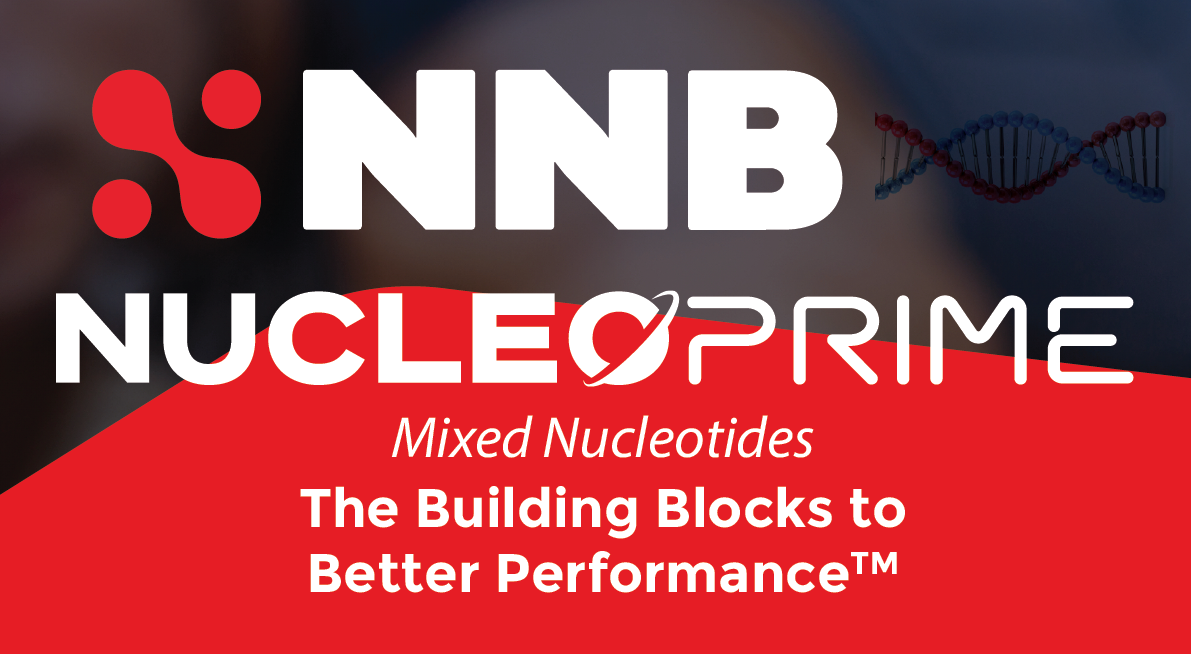
Looking to supplement more of these incredible building blocks? Look to NNB's NucleoPrime!
An alternative option is presented in nutritional supplements that pack a hefty supply of exogenous nucleotides, which have grown in popularity in recent years in line with the demand for general health-promoting products. As we've seen through other products that fall within the niche of cellular health, one particular ingredient developer offers a nucleotide supplement that is at the top of the pack.
NucleoPrime from NNB Nutrition is not the innovative formulator's first foray into health-promoting products, but it may prove to be its most central. In NucleoPrime, NNB supplies a mixture of exogenous nucleotides that are vital to functioning, facilitating countless processes that ultimately allow the body to fire on all cylinders. Containing equal parts AMP, GMP, UMP, and CMP, this ingredient provides the core nucleotides that, while useful themselves, serve as building blocks for the creation of additional nucleotides like ATP and UTP.
All the hallmarks of an NNB product

NNB Nutrition is an innovative ingredient development company with an elite team of over 100 scientists from over 10 countries.
Of course, NNB doesn't simply manufacture and release a product without going the extra mile to ensure its quality. NucleoPrime is a 100% natural, non-GMO, non-allergenic, vegan/vegetarian-friendly variant of exogenous nucleotides, free of any excess materials that sometimes enter the fold during formulation. Verified of its composition through high-performance liquid chromatography, NNB also ensures that every NucleoPrime product contains between 24 to 26% of the four nucleotides AMP, GMP, UMP, and CMP. Additionally, NucleoPrime is GRAS certified by the FDA. All of these certifications not only confirm the contents of the supplement and its safety, but they also assure consumers that they're getting exactly what the label says. This assurance, which always comes alongside an NNB ingredient, cannot be taken for granted!
All things considered, NucleoPrime is among the top options when it comes to dietary nucleotide supplementation. Since we've already covered what these molecules do in the body, let's get into the research that supports the use of exogenous nucleotides and what they can do for you.
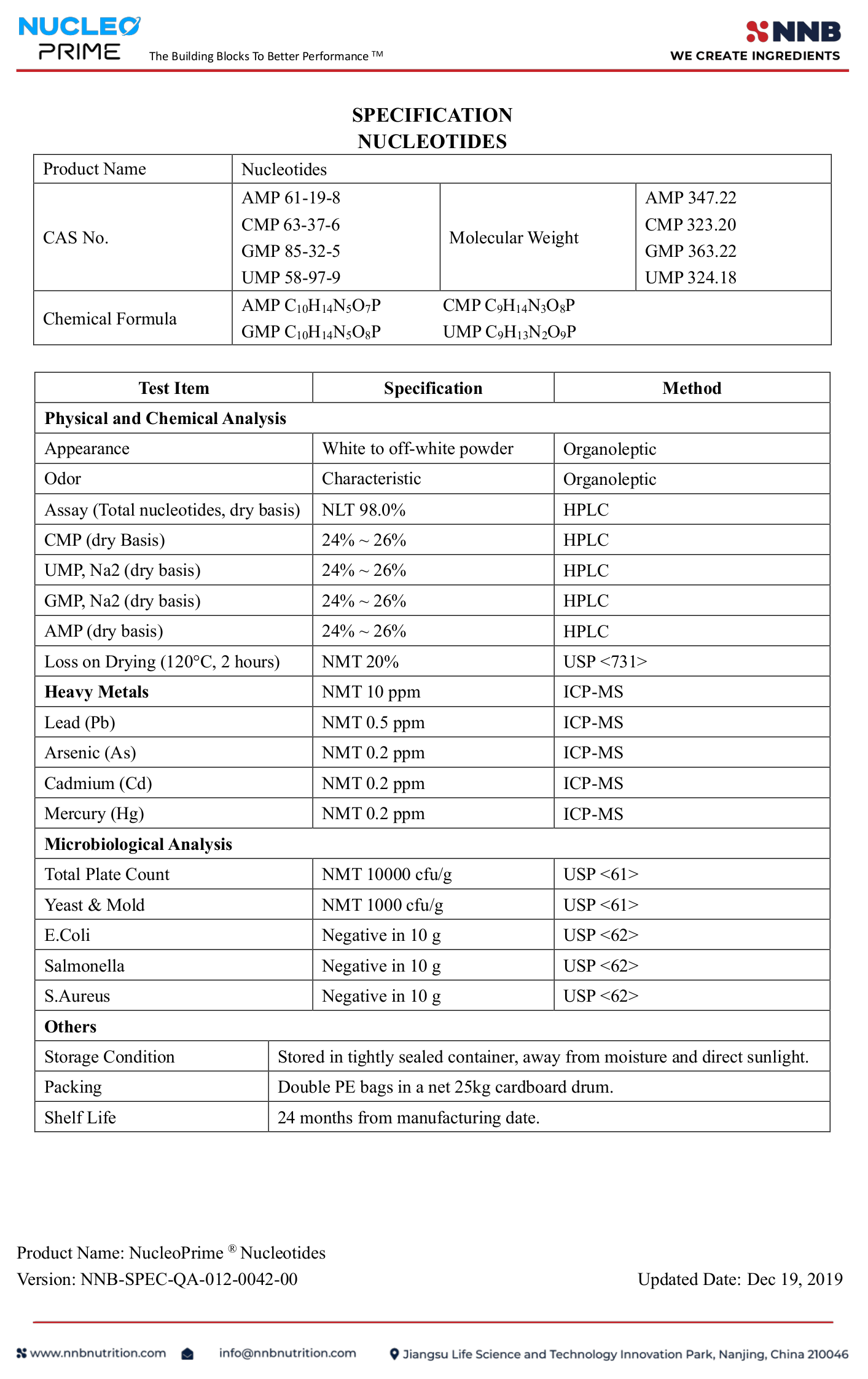
An example NucleoPrime Specification sheet, showing equal (24-26%) parts AMP, GMP, UMP, and CMP. More lab tests can always be provided by contacting us or NNB at NNBNutrition.com
Adding NucleoPrime into your mitochondrial support stack
NucleoPrime is an extremely versatile supplement, and can help with nearly everything, as it relates to molecules that touch nearly everything. On one hand, it can be used as a "life booster" in anything from multivitamins to testosterone optimizers. And on the other hand, it can be used in ATP-enhancing supplements such as creatine, CoQ10, and PQQ.
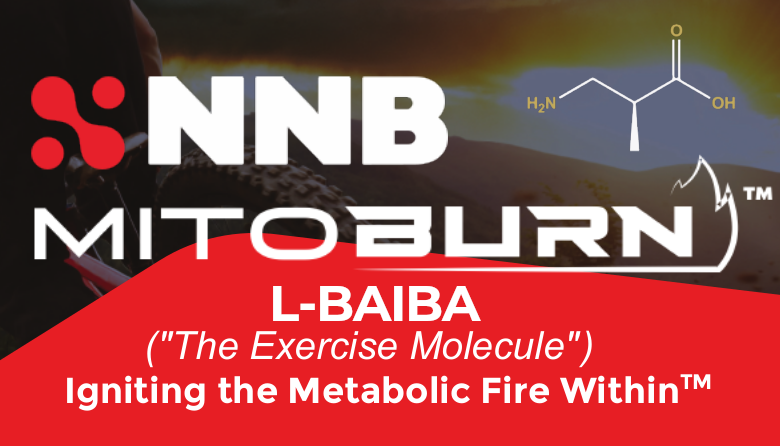
NNB Nutrition has finally brought us a trusted and tested form of L-BAIBA, which we call an "exercise signal" that kickstarts incredible metabolic processes! It's known as MitoBurn and it helps kick-start the 'exercise program'!
Finally, there are specialty products such as anti-aging / longevity supplements that could use more building blocks to accomplish their goals. On top of stacking with mitochondrial boosting ingredients like MitoPrime L-Ergothioneine and patent-pending MitoBurn L-BAIBA, we see NucleoPrime as a fantastic addition to NAD support supplements like NMN (NNB Nutrition's BioNMN to name one in the top tier).
The opportunities are endless, but if you're building a supplement or supplement stack to get from point A to point B, you're going to need the bricks to build the road - and NucleoPrime provides just those bricks.
Where to try NucleoPrime
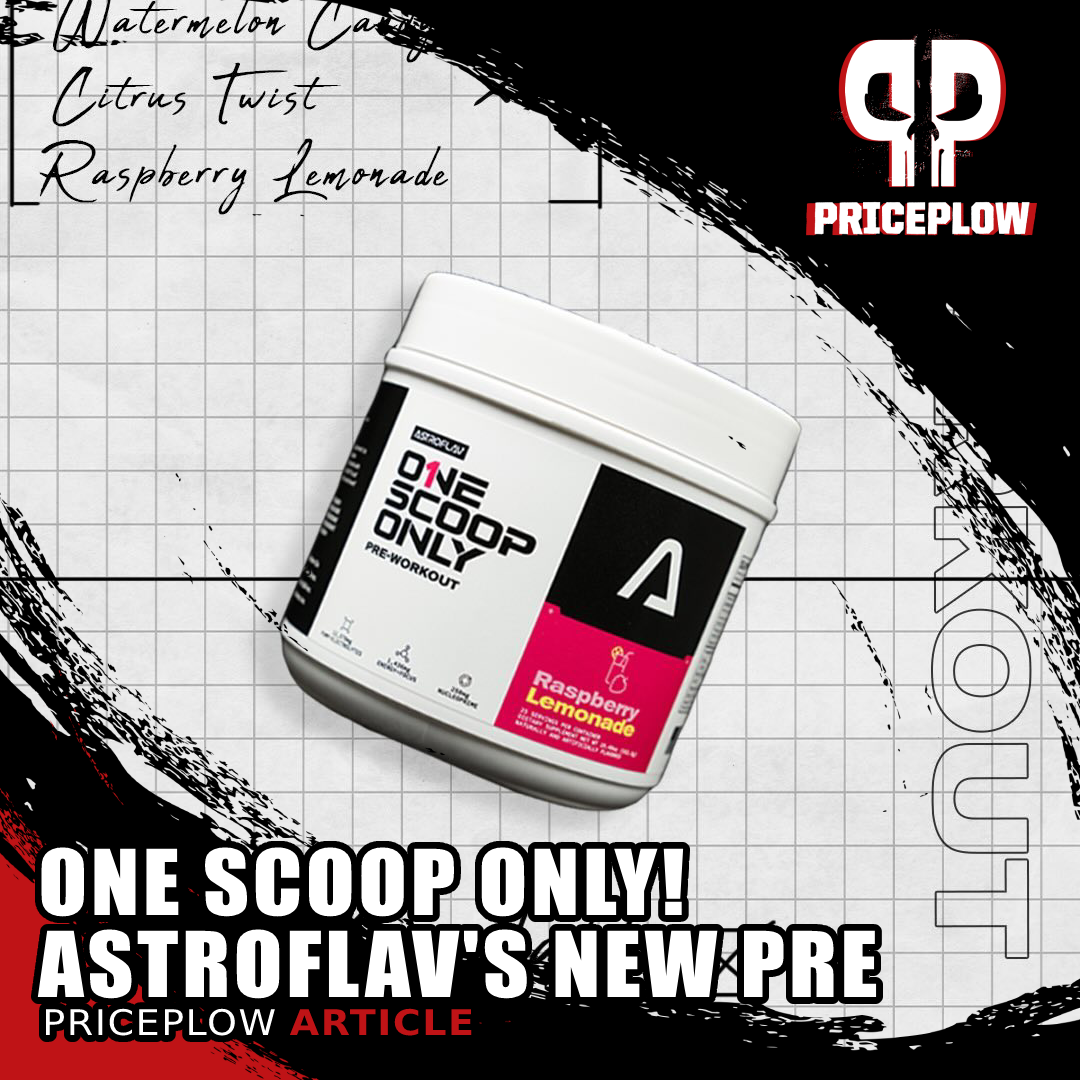
One Scoop Only! It's AstroFlav's epic new pre-workout supplement -- the first to use NucleoPrime Nucleotides!
In late 2022, the first pre-workout supplement to include NucleoPrime came out, named AstroFlav One Scoop Only.
Supporting overall health and wellness via nucleotides
These organic compounds power numerous processes, from energy production to immune functioning, and even play a role in optimizing athletic performance. Often manufactured from scratch or through salvaging at the molecular level, nucleotides can also be obtained through the diet and supplementation. Thus, exogenous nucleotides open a path toward health optimization, providing an additional supply of fuel to the numerous systems that demand it.
NucleoPrime from NNB Nutrition is a science-backed, chemically pure nucleotide mixture that does just that. This supplement, coming from one of the industry's most innovative, science-based formulators, delivers multiple nucleotides to the body in effort to boost available nucleotide pools. This has the potential to not only provide general health and wellness support, but may also increase performance and recovery in athletic endeavors, as well. Nucleotides hold broad responsibilities in the body, and as such, NucleoPrime is capable of delivering a wide array of potential benefits.

NucleoPrime: The Building Blocks to Better Performance
All PricePlow Articles Mentioning Nucleotides
Subscribe to PricePlow's Newsletter and Alerts on These Topics
Mechanism: Generating RNA or DNA
Above, we discuss that these molecules dictate genetic coding, and that there are five nucleobases — adenine, guanine, cytosine, thymine, and uracil — that form nucleotides, which form nucleic acids when stranded together.[2]
For nucleotides, if the attached sugar molecule is ribose (C5H10O5), then the monomer forms RNA; alternatively, if it's deoxyribose (C5H10O4), then it forms DNA.[1] While adenine, guanine, and cytosine are used to make both of these nucleic acids, thymine is exclusive to DNA, while uracil exists only within RNA.
Through forming hydrogen bonds, the nitrogenous bases come together to form base pairs, which one may recognize, visually, as a "rung of the DNA ladder."[31] Cytosine always bonds with guanine, while adenine always bonds with either thymine (if in DNA) or uracil (if in RNA).[31] This relationship exists due to the molecular structure of nucleotides themselves — cytosine, thymine, and uracil are pyrimidine bases (heterocyclic amines with two nitrogen atoms in a six-member ring), while adenine and guanine are purine bases (heterocyclic amines made up of a pyrimidine ring fused to a five-member ring with two nitrogen atoms).
The sequencing of these bonds lies at the center of what makes each living organism unique. For instance, the human genome contains approximately 3 billion base pairs that genetically describe one individual human being![32] These monomers are quite important, both as independent molecules and as components of larger macromolecules. In order to keep an ample supply of nucleotides circulating, the body is capable of building them through multiple methods.
How are nucleotides synthesized?
With a basic composition of organic compounds, nucleotides are formed through two different pathways: de novo pathways and salvage pathways. In the former, nucleobases are synthesized from organic compounds, essentially forming nucleotides from scratch. In contrast, the salvage pathway re-attaches the base to a ribose, recycling a pre-existing base. These processes aren't exactly the same, however. The formation of purines and pyrimidines are slightly different, particularly when it comes to de novo synthesis.
Purine de novo synthesis
The creation of purine nucleotides is a multi-step process in which the purine ring is formed through various biological reactions. The formation of this ring begins with the conversion of ribose-5-phosphate into phosphoribosyl pyrophosphate (PRPP), which is followed by the conversion of adenosine triphosphate (ATP) into adenosine monophosphate (AMP).[8] PRPP and glutamine then combine to yield 5-phosphoribosylamine, facilitated by an enzyme called glutamine phosphoribosyl pyrophosphate amidotransferase.[33] 5-phosphoribosylamine is used to create glycinamide ribonucleotide through an ATP-dependent reaction, which is then attached to a formyl group. At this point, a nitrogen atom from glutamine acts as an electron donor to ultimately form a five-member ring. The amino acid aspartate adds another nitrogen atom via an ATP-dependent reaction, and through its subsequent breakdown into fumarate, attaches a carbon fragment to the five-member ring. After all of this takes place, the resulting molecule is called inosine monophosphate (IMP), which serves as a precursor to AMP and guanosine monophosphate (GMP) formation.
IMP is converted into AMP using guanosine-5'-triphosphate (GTP) and aspartate in a one-step reaction. GMP is formed through two reactions — nicotinamide adenine dinucleotide (NAD+) facilitates oxidation into xanthine monophosphate, which is then converted into GMP using both glutamine and ATP. AMP and GMP can easily be turned into ATP and GTP by attaching phosphate groups.[8] Each of these nucleotides serves an important role in regulating biological functioning.[34]
Pyrimidine de novo synthesis
The key difference between the formation of purine nucleotides and pyrimidine nucleotides is that the former adds a pyrophosphate to a ribose sugar, whereas the latter adds a ribose (from PRPP) after the complete formation of the pyrimidine ring.
Pyrimidine de novo synthesis begins with the formation of carbamoyl aspartate, which is then stripped of a water molecule to yield dihydroorotic acid.[8,35] After being oxidized into orotic acid, this molecule reacts with PRPP to form orotidine-5-phosphate,[8,35] which itself is then decarboxylated into uridine-5-phosphate (UMP).[8,35] UMP, one of the two major pyrimidine nucleotides, can be phosphorylated into uridine diphosphate (UDP) and uridine triphosphate (UTP) through the conversion of ATP to adenosine diphosphate (ADP).[8] UTP, through a reaction facilitated by ATP and glutamine, can be converted into cytidine triphosphate (CTP), a form of the other major nucleotide, cytidine.[8,35]
The salvage pathway
The salvage pathway for both types of nucleotides operates similarly. They leverage the intermediates of the de novo pathway, which are generated through nucleic acid synthesis and degradation. Depending on the type of nucleic acid, these processes release free purines and pyrimidines, which can be turned back into nucleotides through phosphoribosyltransferases.[37]
While the biological synthesizing of nucleotides is rather complex, it's evident how intertwined they are. There are many instances when one nucleotide facilitates the production of another. It speaks to the wide array of responsibilities these molecules have in the body and their influence in countless processes and mechanisms that are vital for healthy functioning. Serving crucial roles in the regulation of cellular growth and homeostasis, energy metabolism, and immune health, nucleotides are among the most powerful biological constituents in the body.
Nucleotides: Often misunderstood, but key building blocks to healthy life
The complex machine that is the human body is capable of some truly impressive feats. In order to efficiently do all it needs to, however, we need to supply it with the required nutrients — fuel, yes, but also all the vitamins, minerals, and other compounds that assist in functioning, too.
Nucleotides are one of these key nutrients, and considering just how influential they are in the body, it's incredibly important that we have large pools from which the body can draw from. We've discussed the importance of mitochondrial health in the past, but the missing piece of many people's puzzles may be the building blocks itself.
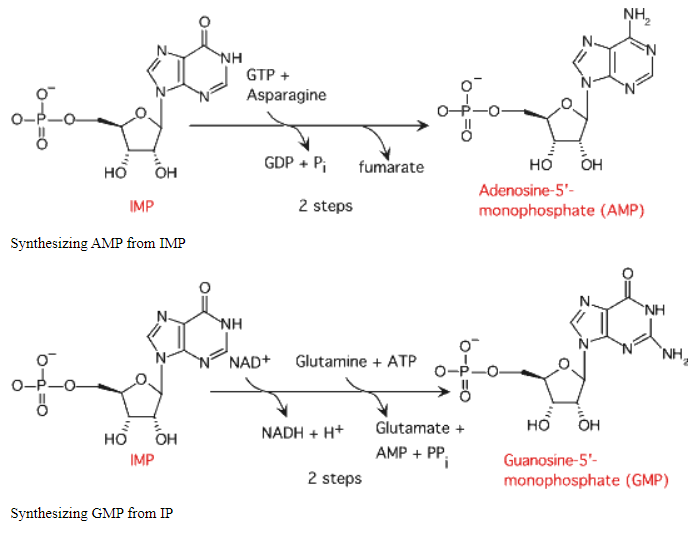
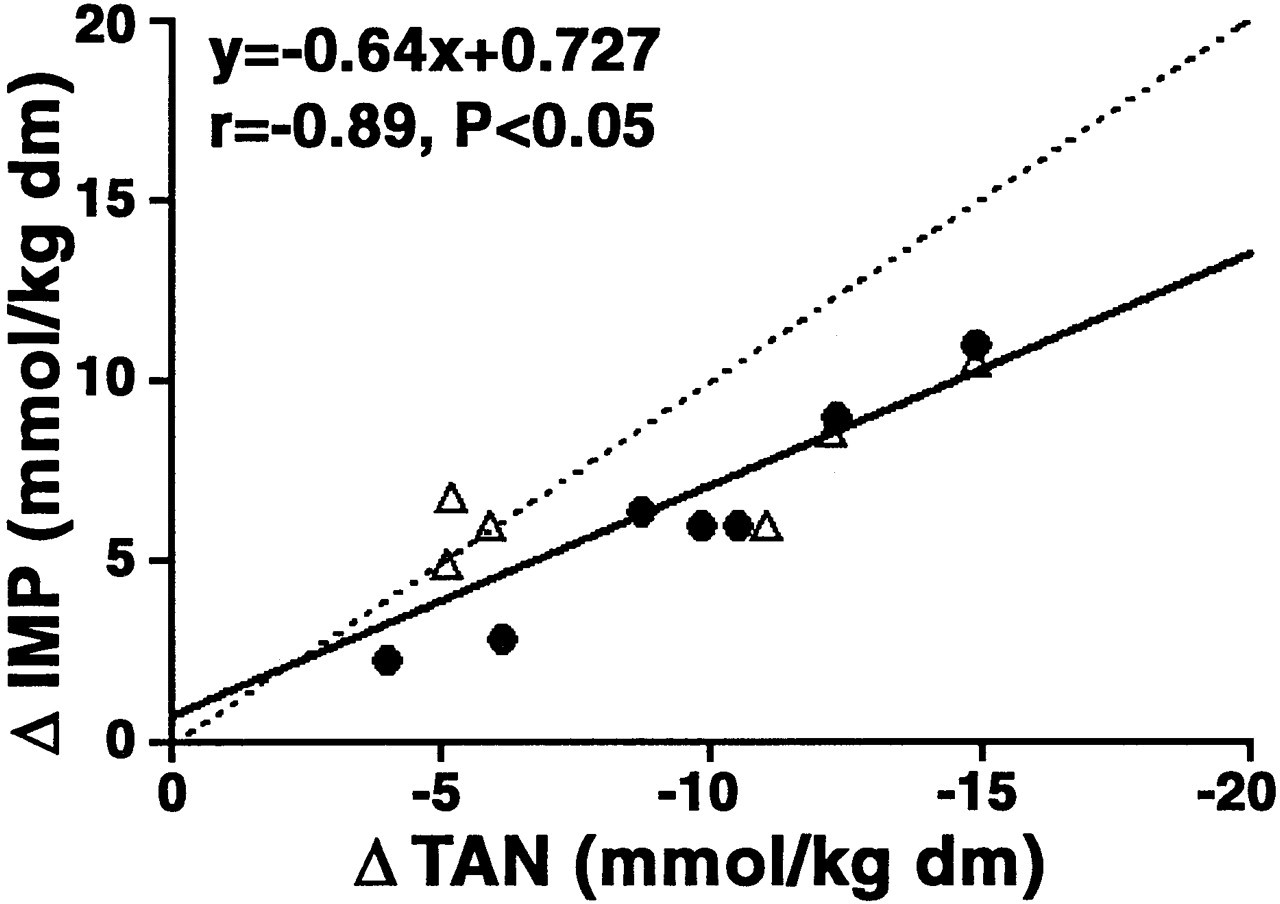
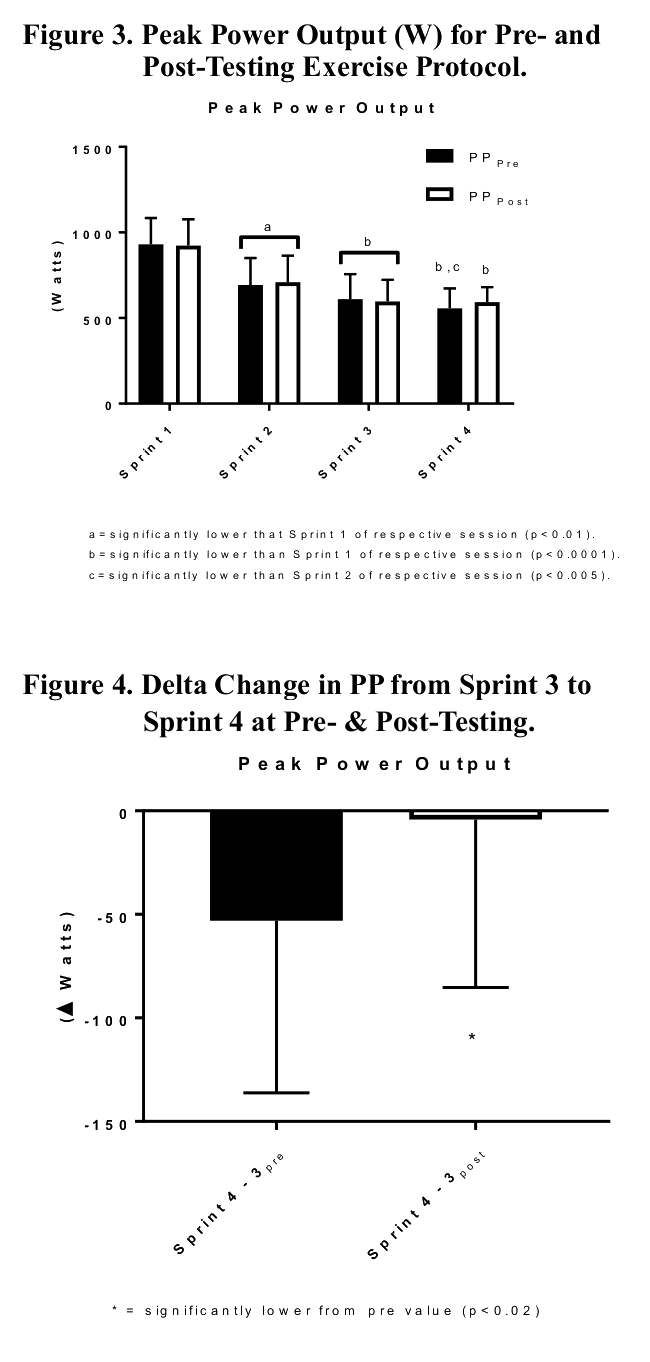
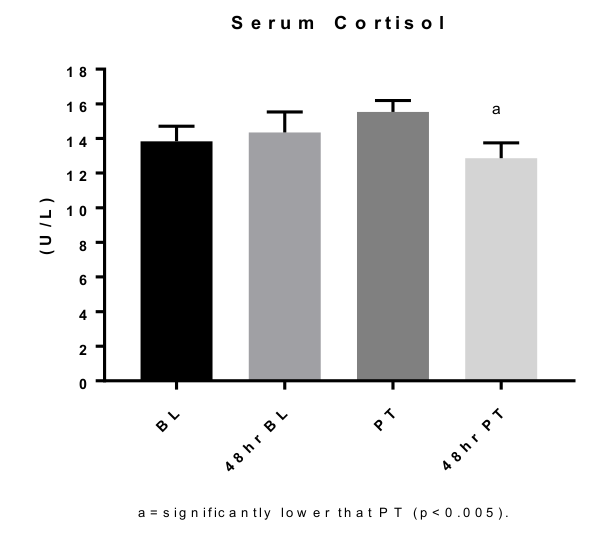
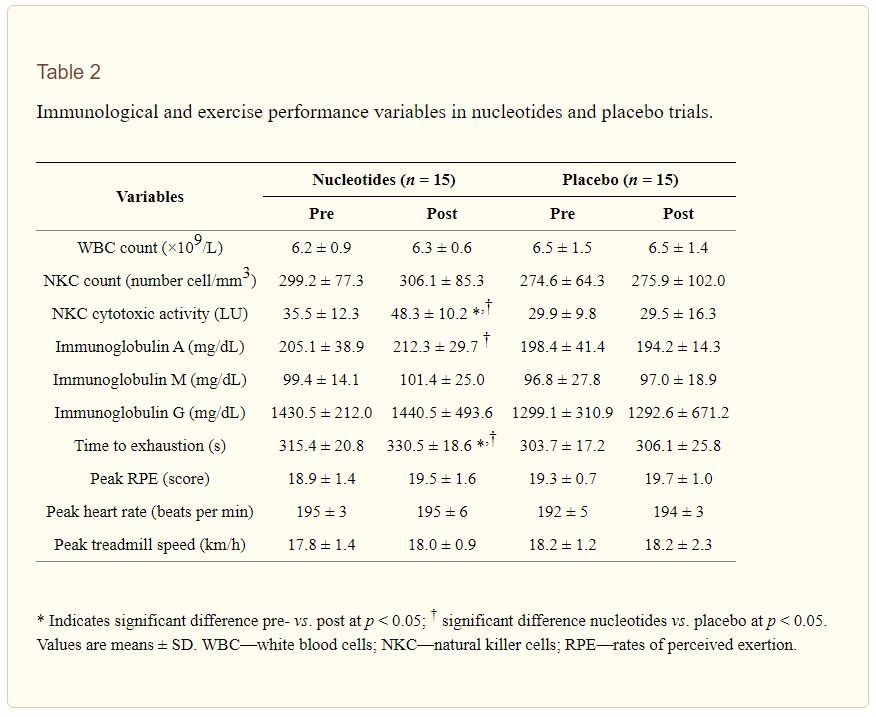
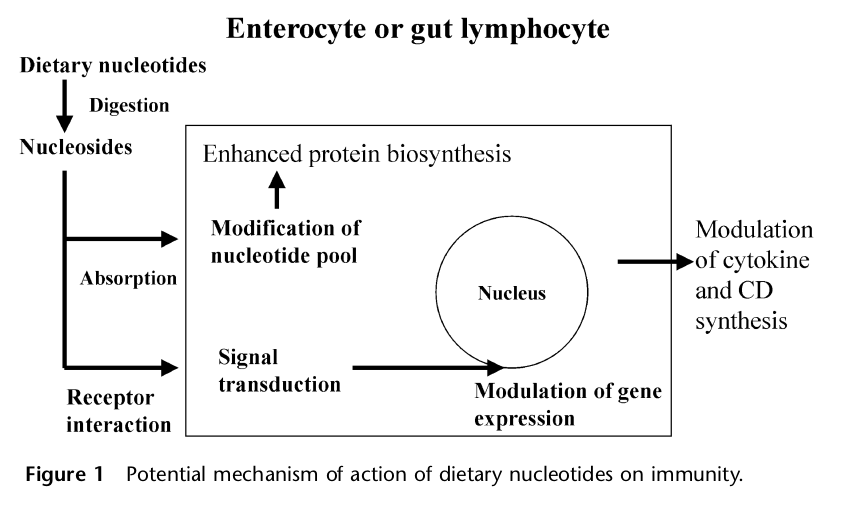
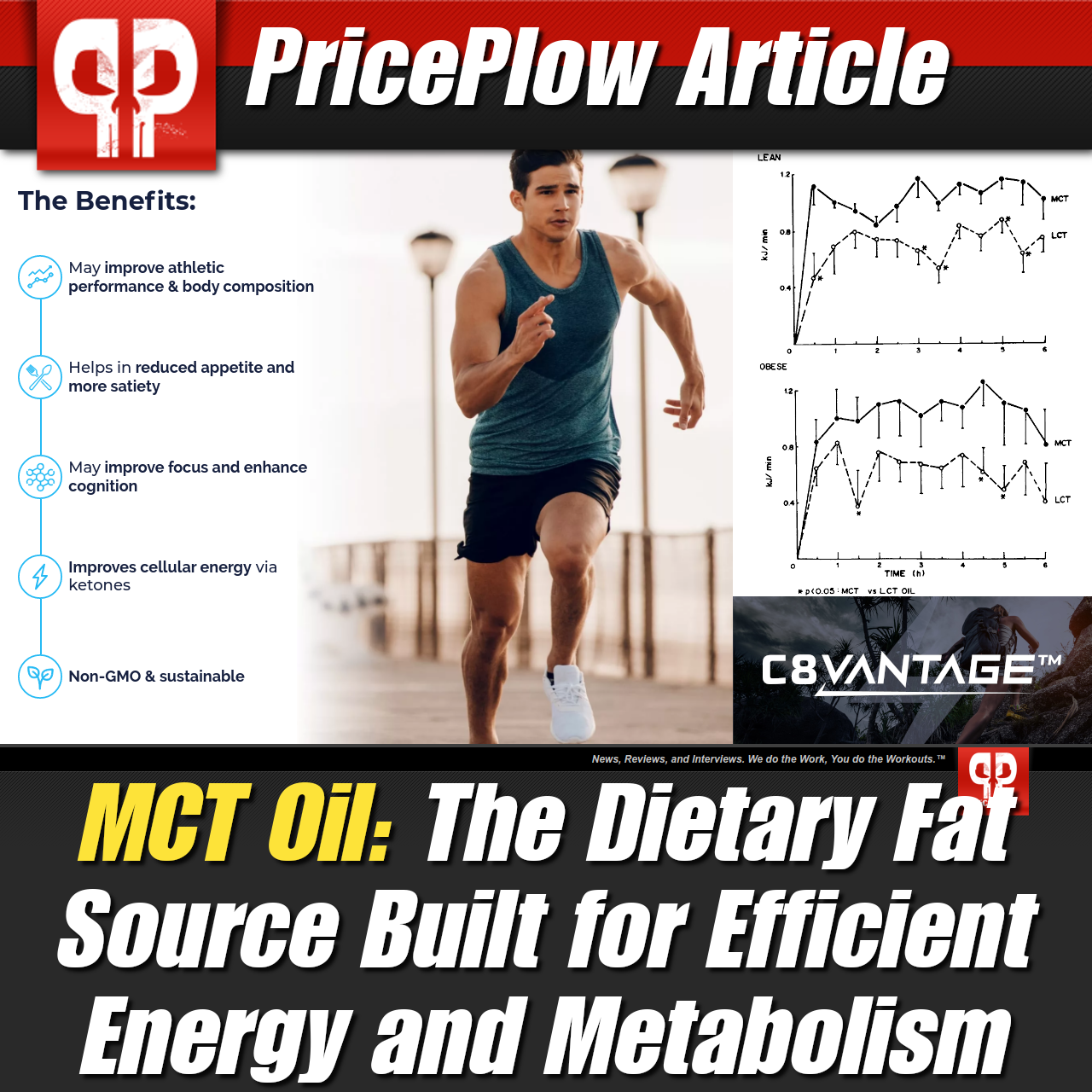

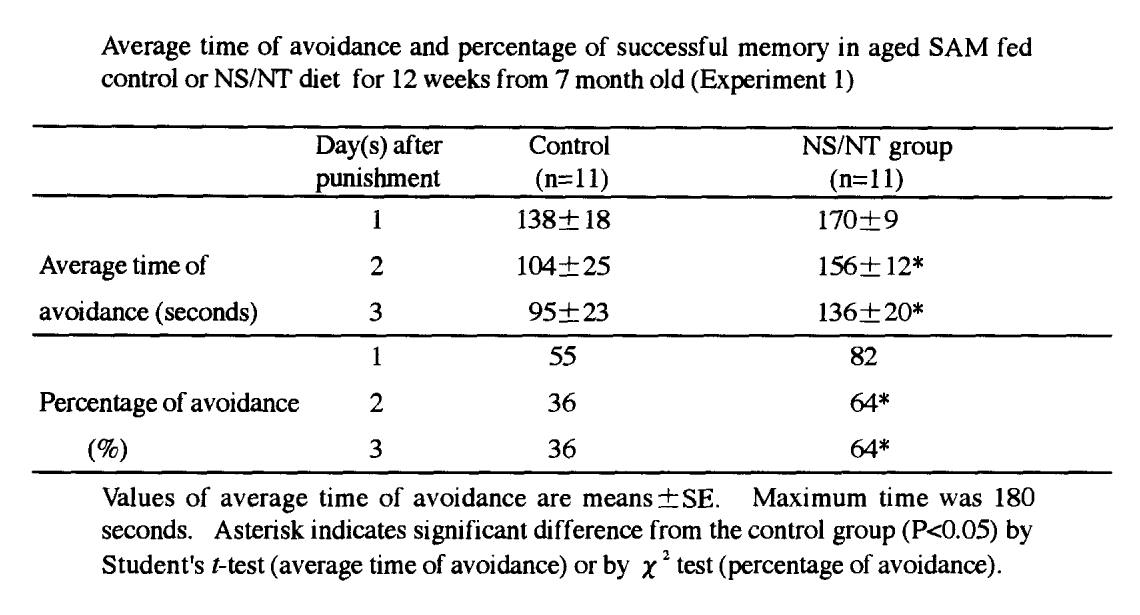
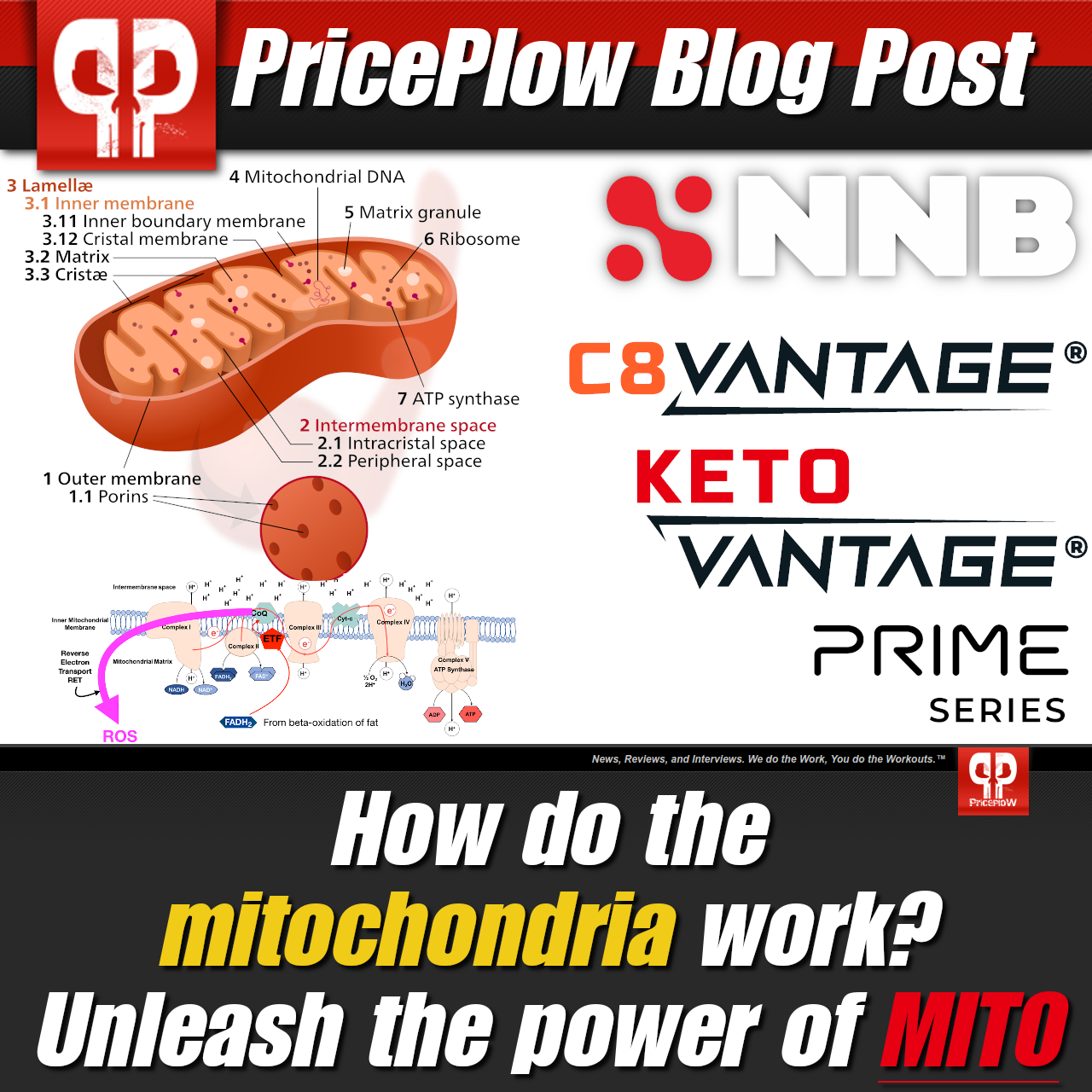

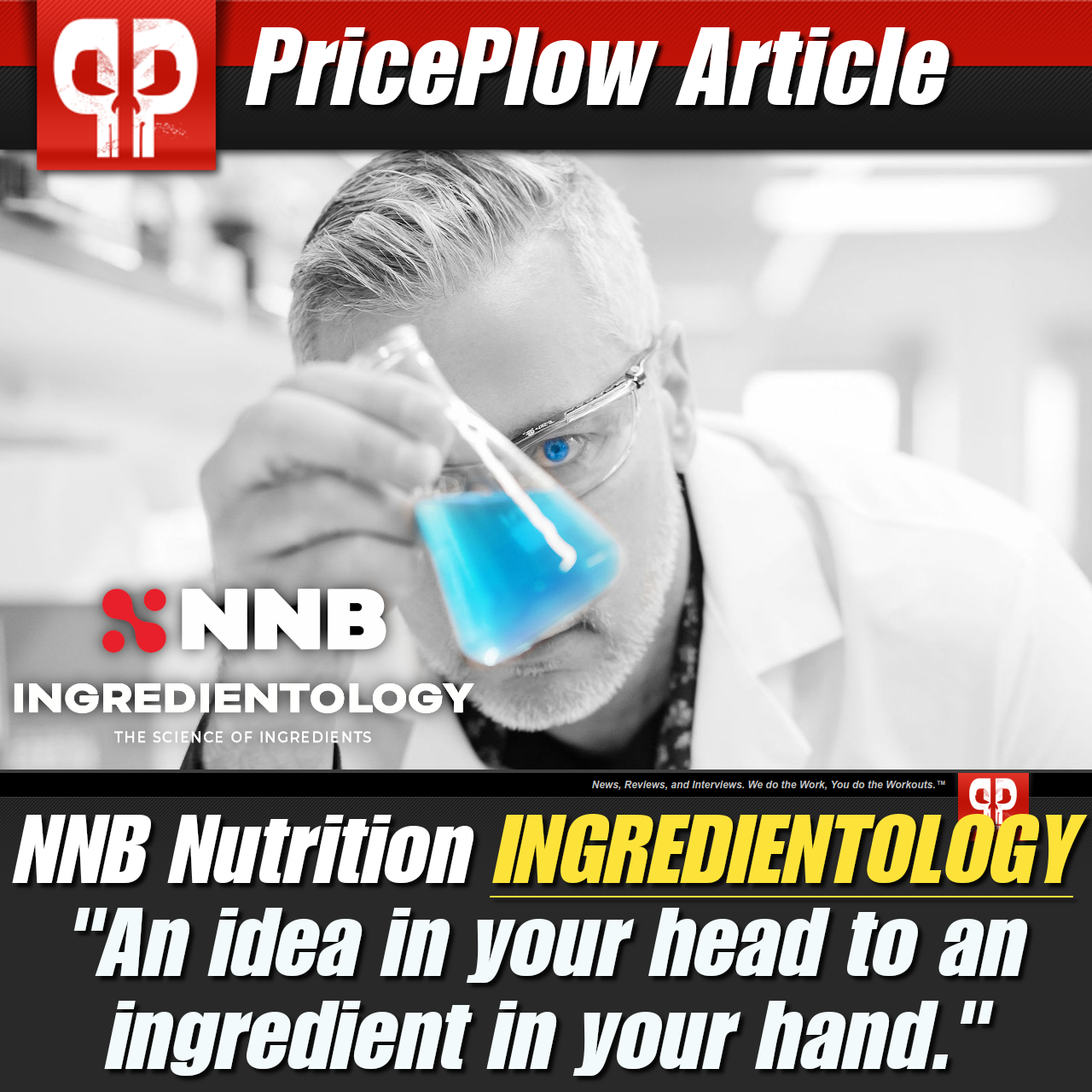

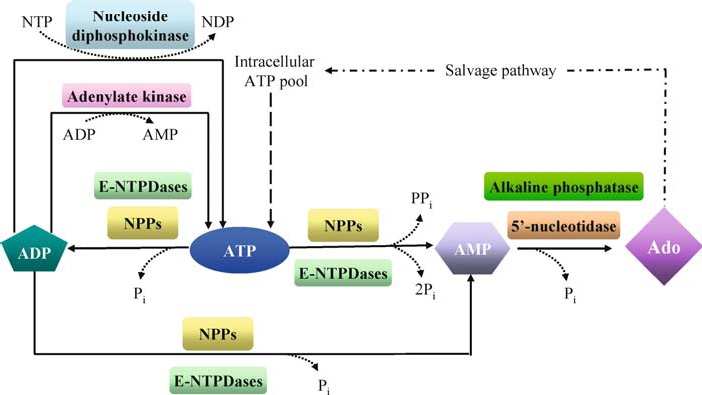


Comments and Discussion (Powered by the PricePlow Forum)